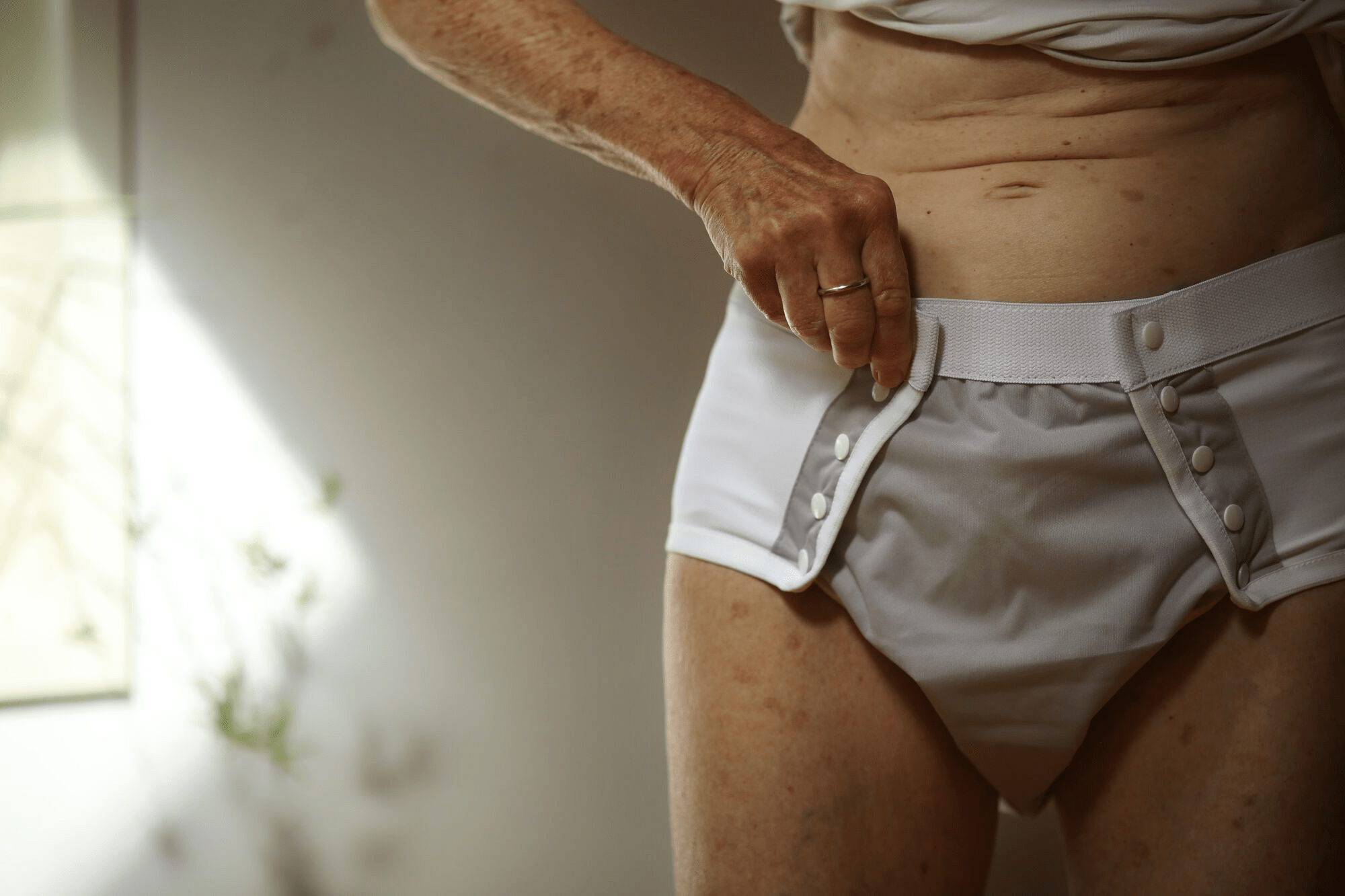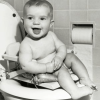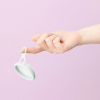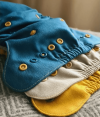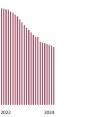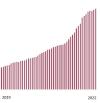Reusable cloth diapers consist of three parts:
-Liner; this is a thin membrane that you put in the diaper if there is a chance of defecation. You throw the liner in the residual waste bin if stool has come on it. If the liner sheet only got wet, you can safely wash it several times and therefore reuse it.
-Absorbent part; often made from a natural material such as bamboo or (organic) cotton, sometimes from polyester. This absorbent part collects the urine and also keeps faeces neatly within the edges.
-Water resistant part; this part ensures that the clothes stay dry. Sometimes this is attached to the absorbent part, sometimes it is a loose pair of pants that you put over the absorbent diaper.
After use, you put a reusable diaper in a diaper pail with a washing net or laundry bag. You keep the dirty diapers in it until you wash. Remove any insert with faeces from the cloth diaper immediately before the diaper goes into the diaper pail.
If you are going to wash, you can put the laundry net or the laundry bag with diapers and all in the washing machine. Fortunately, washing machines can rinse and wash very well these days, so you don't have to clean anything by hand. You first let the washing machine do a cold rinse with detergent, followed by the main program at 60 degrees, of course also with sufficient detergent. After washing it is a matter of hanging it up and letting it dry. Many diapers can even be put in the dryer. And then they are ready to use again! Of course you will receive extensive washing instructions from us when you purchase your first reusable cloth diapers from us.
The benefits of reusable cloth diapers
Good for the environment
The environment is often one of the first mentioned arguments and for good reason. Disposable diapers and incontinence material produce 200 million kg of waste per year in the Netherlands. Reusable diapers hardly create any waste. Partly because of this, reusable diapers (both production and washing) emit 1.5 to 2.5 times less CO2 than disposable diapers. In addition, reusable cloth diapers require 7 times less land to produce the raw materials than disposable diapers.
Good for the skin
A second important advantage of reusable diapers is the effect on the skin. We see that the risk of skin rashes is much smaller in babies and children. We also often hear from adult customers that the skin is calmer and the cloth diaper feels more pleasant.
Lower long-term costs
The purchase price of reusable diapers is higher than the purchase price of disposable diapers, but in the long term the costs are many times lower because far fewer diapers are needed. The Health Insurance Act states that both disposable diapers and reusable diapers are eligible for reimbursement from the basic insurance. It is therefore definitely worth checking with your insurance company whether they want to reimburse reusable cloth diapers. Unfortunately, as far as we know, there are currently no insurers that have a contract with a reusable diaper seller. We hope that this will change soon. However, it is possible to purchase products from a non-contracted care provider, of which you can still receive a large portion (often 70%) reimbursed. So be sure to ask if you would like to be reimbursed in part.
What do you need?
How many adult cloth diaper you need depends on how often you want to wash and how many diapers you will use per day. If you need five diapers a day and you want to wash every other day, you need a minimum of 15 diapers. Five diapers for the first day, five diapers for the second day, and five extra diapers for the time the other diapers are in the washing machine and hanging on the line. If you use three diapers a day, you end up with about 9 diapers. If you use 8 diapers a day, you will end up with 24 diapers. If you wash every day you need fewer diapers, if you want to wash less often you need a little more.
Before first use
When your new cloth diapers arrive, you must first wash them at least three times before the first use. This is especially important with natural materials such as bamboo or cotton. These materials hardly absorb moisture when they are new. After three 60 degree washes, your new diapers are ready for use. The absorption is only maximum after about 10 to 12 washes.
When you first start using reusable diapers, it takes a bit of searching to find out what works and how much absorbency you need. In principle, you can start with a minimum absorption capacity, trying to estimate what is needed. If this cloth diaper leaks too quickly for your liking, you know that you may need an extra insert next time. It is therefore nice to test this in the home situation first. If you find it a very annoying idea that the diaper would leak a bit, you can also think the other way around. If the diaper is not yet saturated at the next changing moment, you may also want to try with one less insert. Do not forget to put an insert in the diaper with every change if there is a risk of faecal leakage. With an insert you can easily throw away any faeces, after which the cloth diaper can still be used in the diaper pail. If the insert has only become wet, you can leave it in the diaper and it will be washed as well. You can then reuse this.
Which adult cloth diaper should you choose?
The choice of an adult diaper is personal and depends on various factors. If you lose a lot of urine, for example, you need much more absorption capacity than if you only have faecal incontinence. On our website you will find the absorption data of all diapers and inserts that we sell. This data indicates the minimum amount of ml the cloth diaper can handle. In general, the maximum absorbency is about twice as high. If you don't know exactly what you need in terms of absorbency, you can calculate it yourself using a used disposable diaper. If you subtract the weight of a dry, clean disposable diaper from the weight of a full disposable diaper, you know how many ml has been absorbed. One gram is one ml. In our experience, the amounts claimed to be absorbed by disposable diapers are generally unrealistic. Often these diapers are filled to the point of dripping or tearing. In practice, such a diaper will leak much sooner. To give a concrete example; the Absorbing Ultra Night disposable diaper should hold 4400 ml. In practice, this leaks through our customers sooner than the Blümchen Junior/Adult diaper, which, according to our test results, absorbs 'only' 565 ml with a bamboo insert.
There are no special reusable adult diapers for men and women. The cloth diapers generally have the same model. However, it may be necessary for men to have extra absorbent capacity in the front. To do this, you can simply fold one of the inserts in half at the front. You can often put this in a pocket opening, but placing it loose on the diaper also works in most cases.
Of course it is always possible to try on the diapers at home. Unwashed items may be returned within 100 days with their original product packaging. If you want to use the cloth diapers for a while to see if it is right for you and to make a decision for the right diaper, you could also rent the diapers. We have special rental packages available, please contact us.
Can't figure it out or do you have questions?
Always feel free to contact us. We are very happy to help! We can be reached by telephone, email, WhatsApp, Social Media channels and via our online chat on the website.
Written by Ilka, owner Nappy's.nl
